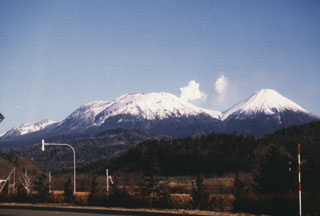Report on Akan (Japan) — 12 November-18 November 2008
Smithsonian Institution / US Geological Survey
Weekly Volcanic Activity Report, 12 November-18 November 2008
Managing Editor: Sally Sennert.
Please cite this report as:
Global Volcanism Program, 2008. Report on Akan (Japan) (Sennert, S, ed.). Weekly Volcanic Activity Report, 12 November-18 November 2008. Smithsonian Institution and US Geological Survey.
Akan
Japan
43.384°N, 144.013°E; summit elev. 1499 m
All times are local (unless otherwise noted)
On 17 November, JMA raised the Alert Level for Me-Akan (also known as Meakan-dake, which means Meakan Peak) of the Akan volcanic complex to "near-crater warning" (levels 2 and 3 on a 5-level scale) after the seismic network detected tremor that lasted 171 minutes. On 18 November, the summit was obscured by cloud cover but web camera views showed that the snow-covered S slopes had turned black. During an overflight later that day, JMA scientists noted that the ash covered an area up to 400 m away from Ponmachineshiri crater. Ballistic lithics several tens of centimeters in diameter were deposited around the crater.
Geological Summary. Akan is a 13 x 24 km caldera located immediately SW of Kussharo caldera. The elongated, irregular outline of the caldera rim reflects its incremental formation during major explosive eruptions from the early to mid-Pleistocene. Growth of four post-caldera stratovolcanoes, three at the SW end of the caldera and the other at the NE side, has restricted the size of the caldera lake. Conical Oakandake was frequently active during the Holocene. The 1-km-wide Nakamachineshiri crater of Meakandake was formed during a major pumice-and-scoria eruption about 13,500 years ago. Within the Akan volcanic complex, only the Meakandake group, east of Lake Akan, has been historically active, producing mild phreatic eruptions since the beginning of the 19th century. Meakandake is composed of nine overlapping cones. The main cone of Meakandake proper has a triple crater at its summit. Historical eruptions at Meakandake have consisted of minor phreatic explosions, but four major magmatic eruptions including pyroclastic flows have occurred during the Holocene.

